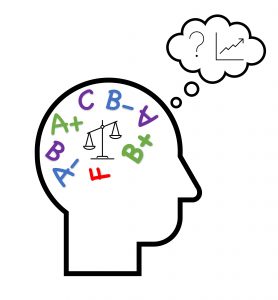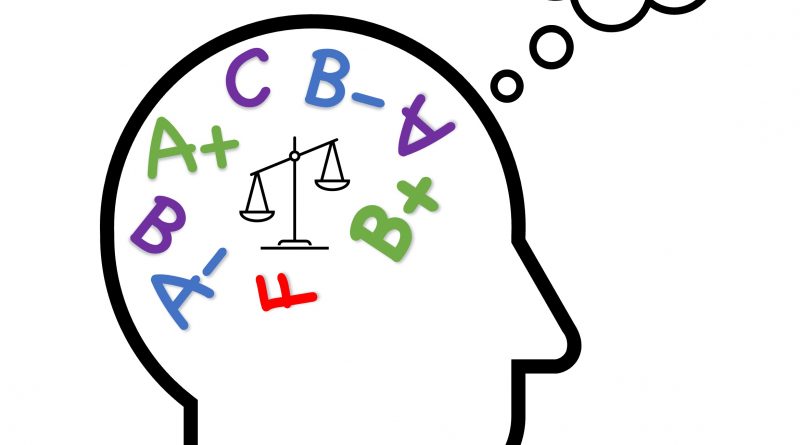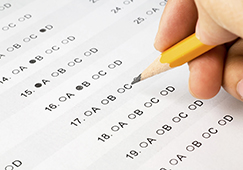The Troubles with Grading & Grade Inflation

by Carie Cardamone, Associate Director, CELT
Why are we struggling with grading this year?
We want grades to be an accurate and useful depiction of students’ learning and achievement in a course, but in practice this is challenging. When we moved to remote teaching, we reexamined our beliefs and practices on many fronts as disparities across student identities became more visible. We questioned how much work was reasonable, we recreated assessments, built in more flexibility, and reflected on how we would know if students had met the course expectations. As our policies and our graded work changed, we worried about academic honesty and how to create fair and representative grades. This year we are all struggling to overcome disengagement and manage limited time resources, while adjusting to in-person modalities with some of us out sick each week. We are also looking back over the last few years and questioning our practices around grading – Have our grades changed? Are we being too easy in assigning grades? What does a grade mean? Are we a less rigorous institution if our students are overall receiving higher grades than in previous years?
What’s in a grade?
From course to course, what contributes to a final grade varies widely. Some grades include percentages tied to behavior factors that may contribute to learning (e.g., effort, participation, attendance, attitude, etc.). Other grades may be based on group projects, homework assignments, quizzes, final exams and all sorts of creative products. Some are heavily exam based and others writing focused. Each of our disciplines makes assumptions that particular forms of assessment can be designed to be objectively accurate at capturing learning – but this is often more subjective than we might believe. There is a complex relationship between each of these graded assessments and a student’s actual knowledge and skills. Does a good test taker know more than someone less skilled in test taking?
Many factors unrelated to learning impact both students’ performance and teachers’ evaluation of student work. Individual differences in culture, background and preparation can impact the way a student comprehends a test question or assignment instructions – often differently from how the instructor intended. Moreover, factors unrelated to learning (e.g., language, cultural context, an instructor’s perceptions of attitudes and effort) bias grades to advantage some groups of students over others. At the heart of the problem is that grades themselves don’t provide us with information about WHAT a student has actually learned.
What’s normal?
About a century ago the idea of grading on a curve, i.e. using a normal distribution with the A-F scale, was introduced as an attempt to standardize grades across contexts. However, the belief that for a large enough group of students a grade should follow a normal distribution is based on an assumption that ability and intelligence are normally distributed in a population. As Bowen & Cooper (2022) elaborate, “most scholars now believe this is not true, particularly given the array of social and cultural influences at work”. The normal distribution itself was created to describe random outcomes, not human performances. As Bloom 1971 writes, “Since education is a purposeful activity in which we seek to have the students learn what we teach, the achievement distribution should be very different from the normal curve if our instruction is effective.” Most of our students at Tufts were in top % of the curve to get here, so why do we assume all students would not be able to be highly successful?
Since education is a purposeful activity in which we seek to have the students learn what we teach, the achievement distribution should be very different from the normal curve if our instruction is effective.
Benjamin Bloom, 1971
Using a normal distribution to scale grades can provide a convenient way to sort and rank a large number of students based on their perceived merit. Unfortunately, rather than selecting for “the best of the best”, the practice tends to select most strongly against those who have historically lacked access to specific cultural knowledge and resources (Taylor 2022, Nelson 2014). Critically, using grades to sort and rank students relies on a belief in a meritocracy, i.e., that a student’s grade is based on only or primarily on their work ethic and/or their intrinsic intelligence. This fails to account for the systemic structures in higher education that prevent students from having equal opportunity to success (i.e., racism, sexism, ableism, microaggressions, implicit biases, inequitable access to opportunities and resources). As a result, the actual distribution of grades is correlated with students backgrounds and identities.
Why “inflation”?
Grade inflation is tied to the idea that students earning grades higher than those in previous years are unearned and problematic. Concerns about grade inflation are not new (e.g., Tufts Daily: The ABCs of Grade Inflation at Tufts 2022, Inflation it’s not just for the economy anymore 2008, The grade inflation Problem 2004). Inflation is seen as problematic because of a resulting erosion of a normal distribution of grades (e.g., https://www.gradeinflation.com/) and the potential loss of the ability to use grades to identify the “top” students. This assumes the bell curve is a useful tool, which we have already noted as problematic when applied to humans, that grades can be equitable, and that they truly represent only a students achievement. More students becoming successful could mean our teaching is improving or that we are creating structures that increase equity and allow more students to succeed. There are also studies, showing that when minoritized students are able to earn higher grades in introductory courses they are more likely to persist in their studies (Strauss 2021).
Critically, these concerns about inflation prioritize the ranking function of grades, and ultimately they privilege certain students who have mostly been successful in this system because it was built for them. This raises a potential conflict between relying on grades to characterize our institution as selective or elite, and our desire to take anti-racist actions, and to create equitable learning environments for our students. In the end, attempts to combat grade inflation ultimately may serve to restore a normal distribution of grades, but at what cost?
So what’s an instructor to do?
Assigning grades to our students is a key expectation for any instructor. We want these grades to be based on valid assessments that support students’ learning and give a reasonable sense of a student’s knowledge and skills. Rather than worrying about the distribution of grades that you assign, we suggest the following series of questions as helpful in centering student learning and creating an equitable environment as you develop your grading schemes:
- Am I clear about what I want students to learn? Do students know and understand the learning outcomes?
- Are the tasks I ask students to do demonstrating their achievement of the learning outcomes?
- Do assessments ask students to demonstrate skills/knowledge/attitudes beyond what has been taught? If so, where am I expecting students to have accumulated those skills/knowledge/attitudes, and are those expectations reasonable and accurate?
- Are there clear and specific criteria to evaluate the work (minimizing conscious / unconscious bias and judgment)?
- How do I ensure all students are aware of instructor expectations and criteria? (e.g., providing students with grading standards ahead of time)
- Does student performance suggest they are interpreting the tasks the way I intended them?
- Does the scoring relate only to the targeted learning outcomes – i.e., not depend on features of the work unrelated to the course learning (e.g., instructor perceptions of attitude, effort, or behavior)?
- Are there other barriers to students demonstrating what they know and can do? Have I considered –
- Logistical barriers – time to complete an assignment, expensive materials
- Factors preventing students from comprehending the task – language complexity, vocabulary, cultural context
- Task asking students to engage in an activity that requires violating their own cultural norms
- Are there opportunities for students to receive feedback, self-assess and revise their work to close the gap between where they are and where they need to be?
References
Bloom, B. Mastery Learning: Theory and Practice; Block, J. H., Ed.; Rinehart and Winston: 1971.
Bowen, Ryan S., and Melanie M. Cooper. “Grading on a Curve as a Systemic Issue of Equity in Chemistry Education.” Journal of Chemical Education 99, no. 1 (January 11, 2022): 185–94. https://doi.org/10.1021/acs.jchemed.1c00369.
Nelson, Libby. “Black Students Were Hurt Most When Wellesley Tried to Control Grade Inflation.” Vox, August 26, 2014. https://www.vox.com/2014/8/26/6067175/grade-inflation-college-wellesley.
Rojstaczer, Stuart, “National Trends in Grade Inflation, American Colleges and Universities.” Accessed October 28, 2022. https://www.gradeinflation.com/.
Strauss, Valerie, Sept 2021 “Perspective | Grade Inflation Is Just Plain Bad. Right? Maybe Not.”, Washington Post. Accessed October 28, 2022. https://www.washingtonpost.com/education/2021/09/21/why-grade-inflation-is-useful/.
Taylor, C. S. (2022). Culturally and Socially Responsible Assessment: Theory, Research, and Practice. Teachers College Press.




